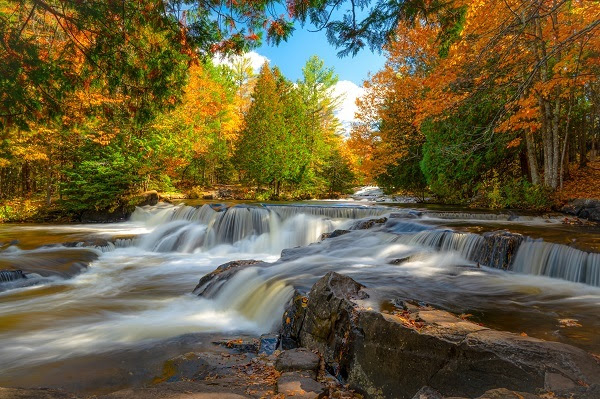| Here are just a few of this week’s stories from the Michigan Department of Natural Resources:
See other news releases, Showcasing the DNR stories, photos and other resources at Michigan.gov/DNRPressRoom.
PHOTO FOLDER: Larger, higher-res versions of most of the images used in this email are available in this folder.
 With Michigan’s firearm deer season starting Wednesday, the DNR reminds everyone to put safety first. This brief video offers safety highlights. With Michigan’s firearm deer season starting Wednesday, the DNR reminds everyone to put safety first. This brief video offers safety highlights.
Lt. Tom Wanless, who heads the DNR’s recreational safety, education and enforcement section, said that although some tips seem like common sense, it’s critical for anyone hunting with firearms to consider safety basics.
“Success is not always about filling your tag, it’s about safely enjoying the experience and sharing it with friends and family after the hunt,” Wanless said.
All hunters should:
- Treat every firearm as if it is loaded.
- Be aware of your surroundings – know your target and what is beyond it.
- Unload firearms when crossing obstacles and/or getting in or out of an elevated stand.
- Obey “no trespassing” signs; they are there for a reason.
- Obtain landowner permission to retrieve game that has wandered onto private property.
- Wear “hunter orange” to increase your visibility to other hunters. Hunter orange garments (such as caps, hats, vests or jackets), including camouflage, must be at least 50% hunter orange and be visible from all directions.
During hunting seasons, the DNR strongly encourages nonhunters to wear bright colors, especially hunter orange, and be aware of their surroundings near woods or fields where hunting may occur.
Get more hunting and tree stand safety tips at Michigan.gov/HuntingSafety, and season and regulation details in the 2023 DNR Hunting Regulations Summary.
Questions about safety? Email [email protected]. |
 It was an incredible year for birding across the Great Lakes region, as a number of birds that were outside their normal wintering and breeding areas for various reasons were spotted in our wetlands and along our lakes. Among the rare vagrants were several species native to Florida, including the roseate spoonbill, limpkin and American flamingo. It was an incredible year for birding across the Great Lakes region, as a number of birds that were outside their normal wintering and breeding areas for various reasons were spotted in our wetlands and along our lakes. Among the rare vagrants were several species native to Florida, including the roseate spoonbill, limpkin and American flamingo.
Year-round, hundreds of bird species draw us outdoors as they flit in the treetops, hop through shrubs or run along the shorelines. With winter on its way, birders are excitedly awaiting the arrival of northern finches and owls.
Whether we encounter rare vagrants, irruptive northern breeders – those birds that hit the scene suddenly and in large numbers – or common backyard birds, it’s important to use best birding practices to protect Michigan’s birds and visitors. The following tips and resources from Mi Birds can help guide your next outing.
Keep a respectful distance. Getting too close to birds, and their nests, can cause them to flush (or fly away), interfering with their natural behavior and potentially preventing them from caring for their young or eating. If your approach causes a bird to flush, you’ve gotten too close. |
 Think carefully before sharing the location of a rare bird. While rare bird sightings are thrilling, they can draw a crowd, which can cause a disturbance. Think carefully before sharing the location of a rare bird. While rare bird sightings are thrilling, they can draw a crowd, which can cause a disturbance.
Share the shore. Great Lakes beach-nesting birds, like the Great Lakes piping plover, require special care. By leashing pets and giving birds plenty of space (more than 100 feet, or about 16 beach towels), we can help ensure their survival.
Leave the drones to the pros. Although drones can be useful for researchers and biologists documenting bird populations (such as at island nesting colonies), drones in general can be very disruptive to birds, especially osprey. They also are illegal in national parks, and their use is limited in state parks. (This DNR land use order provides more detail about unmanned aircraft, such as drones.)
Here are additional resources to help protect birds and habitat:
For more birding and wildlife photography best practices, explore Audubon’s library of ethics articles. Enjoy your next birding adventure!
MI Birds is a public outreach and education program presented by Audubon Great Lakes and the Michigan DNR that works to build and bring together wildlife enthusiasts across the state to engage with and conserve Michigan’s birds, wildlife and public lands.
Questions? Contact Erin Rowan Ford at 313-820-0809. |
 From duck, deer and goose to coyote, quail and fox, this month (and beyond) is rich with options to try your hand at hunting and trapping. From duck, deer and goose to coyote, quail and fox, this month (and beyond) is rich with options to try your hand at hunting and trapping.
Whether you’re a veteran hunter of several species, a devoted trapper or someone just getting familiar with the ins and outs of these outdoor traditions, Michigan’s got something for everyone, and the DNR has all of the resources to keep you informed, safe and confident when in the field. In case you missed it, we recently put out a hunting and trapping roundup, complete with season dates and links to more information about places to hunt and trap.
If you have questions about late fall and early winter hunting and trapping opportunities, email the DNR Wildlife Division at [email protected]. |
 See more pictures by Michigan state parks photo ambassadors at Instagram.com/MiStateParks. For more on the program, call Stephanie Yancer at 989-274-6182. (This photo is by Sarah Goodwin, for the Michigan DNR, at Bond Falls Scenic Area in Ontonagon County.) See more pictures by Michigan state parks photo ambassadors at Instagram.com/MiStateParks. For more on the program, call Stephanie Yancer at 989-274-6182. (This photo is by Sarah Goodwin, for the Michigan DNR, at Bond Falls Scenic Area in Ontonagon County.)
|
|
Catch Michigan Makers, the Michigan History Museum exhibit with stories of tinkerers, artists, thinkers and others who shaped our state. Don’t wait; it closes Dec. 3.
|
|
When you purchase things from our Goods4Mi.com partners – apparel, coffee, prints, stickers and more – you also support state parks, trails, waterways and other outdoor spaces!
|
|
|